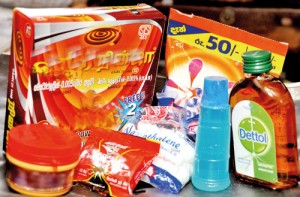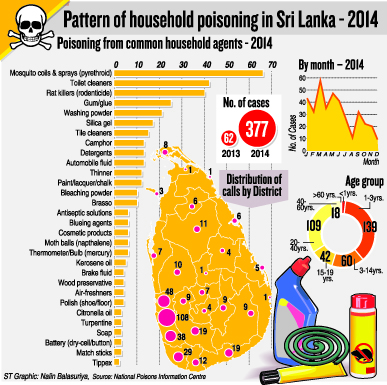News
Household poisoning on the increase
They are all over our houses, in our bedrooms and bathrooms, our garages, store-rooms and kitchens.

The poisonous stuff is freely available in homes
Hardly a glance do we cast at them, but use them frequently. The National Poisons Information Centre of the National Hospital, Colombo, however, has not only looked at them long and hard but also gone a step further to study the pattern of household poisoning through them, in Sri Lanka.
This first-ever, in-depth study covering most household products should open the eyes of men, women and children to the dangers in their very homes.
The worst culprits at the top of the list are mosquito coils and sprays (pyrethroid) with 66 cases of household poisoning, followed by toilet cleaner with 42 cases and rat-killers (rodenticide) with 40 cases. Gum/glue come in next with 25 cases and washing powder with 21 cases, the Sunday Times learns. (See graphic for full list)
“There is a sharp rise in the number of ‘household poisonings’ recorded last year when compared to 2013,” says Dr. Waruna Gunathilake, Head of the Toxicology & National Poisons Information Centre, pointing out that there have  been 377 cases of ‘household poisoning’ in 2014 while there were only 62 cases in 2013.
been 377 cases of ‘household poisoning’ in 2014 while there were only 62 cases in 2013.
These household poisonings, both by accidental and deliberate ingestion, have been recorded at the centre through information received from across the country on its 24-hour hotline.
Even though a higher number may have reported such poisonings in 2014 due to the centre being very active and having a higher profile, Dr. Gunathilake points out that national statistics indicate a rising trend in household

Dr. Waruna Gunathilake
poisonings from 2000 to 2012. The latest figures for 2014 reflect the increase.
Lamenting that poisonous stuff is freely available in homes, Dr. Gunathilake urges that they should be kept under lock and key. The two age-groups which seem most vulnerable to such poisoning are children under three years of age and adults in the 20-40 year group.
“Small children tend to put anything they come across into their mouths,” he says, pointing out that this is why these products need to be out of their reach and locked up so that accidental ingestion cannot take place.
These products not being easily accessible in homes may also prevent some cases of deliberate ingestion on the part of the 20-40 year old group too, he says.
Another warning which comes from Dr. Gunathilake is that the centre has found that many people are buying unregistered rat-poison and no one seems to know where they are produced. “Beware, because these are dangerous substances and can be very harmful,” he adds.

